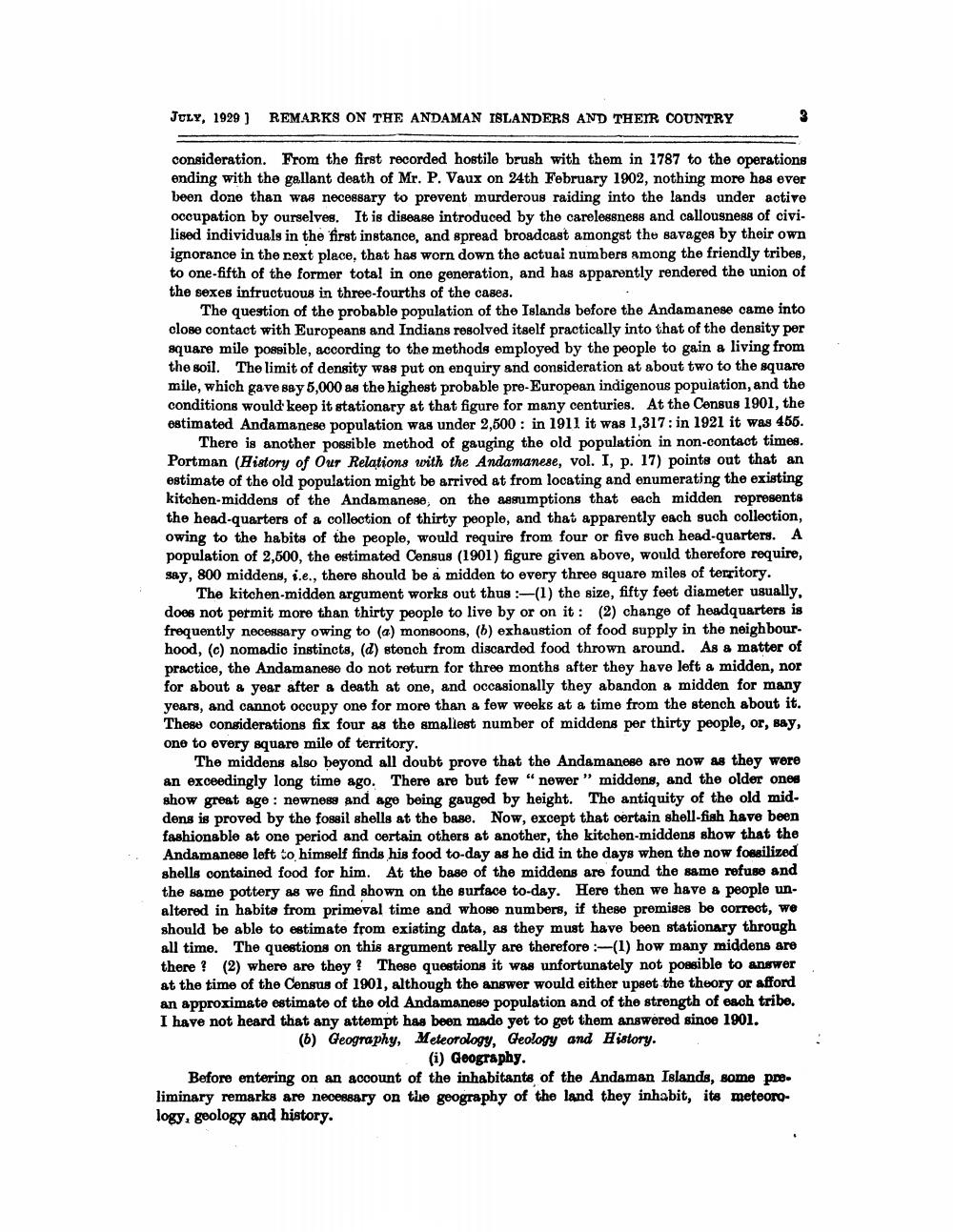________________
JULY, 1929) REMARKS ON THE ANDAMAN ISLANDERS AND THEIR COUNTRY
3
consideration. From the first recorded hostile brush with them in 1787 to the operations ending with the gallant death of Mr. P. Vaux on 24th February 1902, nothing more has ever been done than was necessary to prevent murderous raiding into the lands under active occupation by ourselves. It is disease introduced by the carelessness and callousness of civilised individuals in the first instance, and spread broadcast amongst the savages by their own ignorance in the next place, that has worn down the actual numbers among the friendly tribes, to one-fifth of the former total in one generation, and has apparently rendered the union of the sexes infructuous in three-fourths of the cases.
The question of the probable population of the Islands before the Andamanese came into close contact with Europeans and Indians resolved itself practically into that of the density per square mile possible, according to the methods employed by the people to gain a living from the soil. The limit of density was put on enquiry and consideration at about two to the square mile, which gave say 5,000 as the highest probable pre-European indigenous population, and the conditions would keep it stationary at that figure for many centuries. At the Census 1901, the estimated Andamanese population was under 2,500 : in 1911 it was 1,317: in 1921 it was 456.
There is another possible method of gauging the old population in non-contact times. Portman (History of Our Relations with the Andamanese, vol. I, p. 17) points out that an estimate of the old population might be arrived at from locating and enumerating the existing kitchen-middens of the Andamanese, on the assumptions that each midden represents the head-quarters of a collection of thirty people, and that apparently each such collection, owing to the habits of the people, would require from four or five such head-quarters. A population of 2,500, the estimated Census (1901) figure given above, would therefore require, say, 800 middens, i.e., there should be a midden to every three square miles of territory.
The kitchen-midden argument works out thus (1) the size, fifty feet diameter usually, does not permit more than thirty people to live by or on it : (2) change of headquarters is frequently necessary owing to (a) monsoons, () exhaustion of food supply in the neighbourhood, (c) nomadic instincts, (d) stonch from discarded food thrown around. As a matter of practice, the Andamanese do not return for three months after they have left a midden, nor for about & year after a death at one, and occasionally they abandon & midden for many years, and cannot occupy one for more than a few weeks at a time from the stench about it. These considerations fix four as the smallest number of middens per thirty people, or, say, one to every square mile of territory.
The middens also beyond all doubt prove that the Andamanese are now as they were an exceedingly long time ago. There are but few "nower" middens, and the older ones show great age : newness and age being gauged by height. The antiquity of the old middens is proved by the fossil shells at the base. Now, except that certain shell-fish have been fashionable at one period and certain others at another, the kitchen-middens show that the Andamanese left to himself finds his food to-day as he did in the days when the now fossilized shells contained food for him. At the base of the middens are found the same refuse and the same pottery as we find shown on the surface to-day. Here then we have a people unaltered in habite from primeval time and whose numbers, if these premises be correct, we should be able to estimate from existing data, as they must have been stationary through all time. The questions on this argument really are therefore :-(1) how many middens are there? (2) where are they? These questions it was unfortunately not possible to answer at the time of the Census of 1901, although the answer would either upset the theory or afford an approximate estimate of the old Andamanese population and of the strength of each tribe. I have not heard that any attempt has been made yet to get them answered since 1901. (6) Geography, Meteorology, Geology and History.
(i) Geography. Before entering on an account of the inhabitants of the Andaman Islands, some preliminary remarks are necessary on the geography of the land they inhabit, its meteorology, geology and history.




